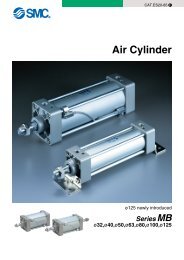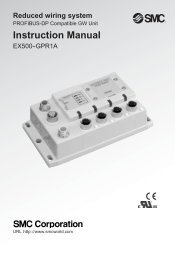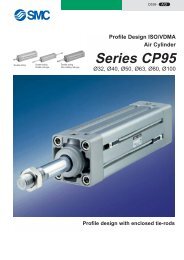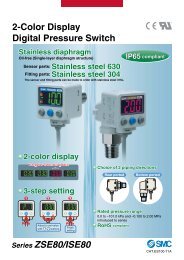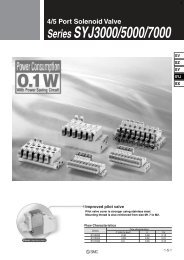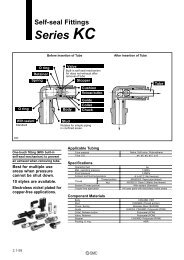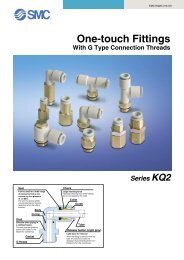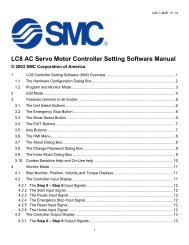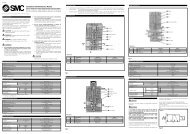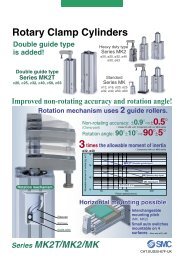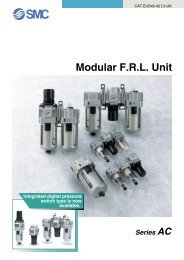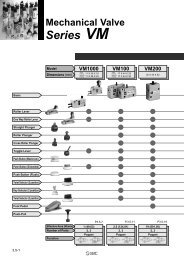Create successful ePaper yourself
Turn your PDF publications into a flip-book with our unique Google optimized e-Paper software.
Series <strong>MSQ</strong>Auto Switch Precations 2Be sure to read before handling.WarningMounting and Adjustment1. Do not drop or bump.Do not drop, bump or apply excessive impacts (300 m/s 2 or morefor reed switches and 1000 m/s 2 or more for solid state switches)while handling.Although the body of the switch may not be damaged, the insideof the switch could be damaged and cause a malfunction.2. Do not carry a cylinder by the auto switchlead wires.Never carry a cylinder by its lead wires. This may not only causebroken lead wires, but it may cause internal elements of theswitch to be damaged by the stress.3. Mount switches using the proper tighteningtorque.When a switch is tightened beyond the range of tightening torque,the mounting screws mounting bracket or switch may bedamaged. On the other hand, tightening below the range oftightening torque may allow the switch to slip out of position.4. Mount a switch at the center of the operatingrange.Adjust the mounting position of an auto switch so that the pistonstops at the center of the operating range (the range in which aswitch is ON). (The mounting positions shown in the catalogindicate the optimum positions at stroke end.) If mounted at theend of the operating range (around the borderline of ON andOFF), operation may be unstable.WarningWiring1. Avoid repeatedly bending or stretching leadwires.Broken lead wires will result from repeatedly applying bendingstress or stretching force to the lead wires.2. Be sure to connect the load before power isapplied.If the power is turned ON when an auto switch is not connected toa load, the switch will be instantly damaged because of excesscurrent.3. Confirm proper insulation of wiring.Be certain that there is no faulty wiring insulation (contact withother circuits, ground fault, improper insulation between terminals,etc.). Damage may occur due to excess current flow into a switch.4. Do not wire with power lines or high voltagelines.Wire separately from power lines or high voltage lines, avoidingparallel wiring or wiring in the same conduit with these lines.Control circuits containing auto switches may malfunction due tonoise from these other lines.WarningWiring5.Do not allow short circuit of loads.If the power is turned ON with a load in a short circuit condition,the switch will be instantly damaged because of excess currentflow into the switch.Model D-M9(V), M9W(V), D-M9 and all models of PNPoutput type switches do not have built-in short circuit protectioncircuits. If loads are short circuited, the switches will be instantlydamaged, as in the case of reed switches.Take special care to avoid reverse wiring with the brown [red]power supply line and the black [white] output line on 3-wire typeswitches.6.Avoid incorrect wiring.A 24 VDC switch with indicator light has polarity. The brown [red]lead wire is (+), and the blue [black] lead wire is ().1) If connections are reversed, a switch will operate, however, thelight emitting diode will not light up.Also note that a current greater than that specified will damagea light emitting diode and it will no longer operate.Applicable models: D-A93, A93V1) If connections are reversed on a 2-wire type switch, the switchwill not be damaged if protected by a protection circuit, but theswitch will be in a normally ON state.However, note that the switch will be damaged if reversedconnections are made while the load is in a short circuitedcondition.2) If connections are reversed (power supply line + and powersupply line ) on a 3-wire type switch, the switch will beprotected by a protection circuit. However, if the power supplyline (+) is connected to the blue [black] wire and the powersupply line () is connected to the black [white] wire, the switchwill be damaged.∗ Lead wire colour changesLead wire colours of <strong>SMC</strong> switches have been changed in order tomeet NECA Standard 0402 for production beginning September,1996 and thereafter. Please refer to the tables provided.Special care should be taken regarding wire polarity during the timethat the old colors still coexist with the new colours.2-wireOutput (+)Output ()OldRedBlackSolid statewith diagnostic outputPower supplyGNDOutputDiagnostic outputOldRedBlackWhiteYellowNewBrownBlueNewBrownBlueBlackOrange3-wirePower supplyGNDOutputOldRedBlackWhiteSolid state with latchtype diagnostic outputPower supplyGNDOutputLatch typediagnostic outputOldRedBlackWhiteYellowNewBrownBlueBlackNewBrownBlueBlackOrange38



